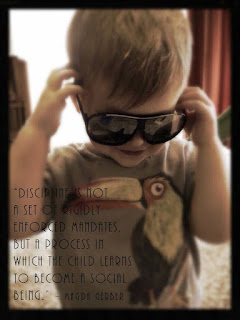Preventing Power Struggles with Choices and Effective Limits
Have you ever tried to follow the experts’ recommendations to give your child choices, but it turned into a huge meltdown? Or tried to set a limit by giving two options, only to have your child insist on a third option?
I recently had a conversation with a friend about her daughter, nearly three years old, who has been having some trouble with making decisions. They have been getting into power struggles, especially around using the potty. I asked my friend if she was giving choices and sufficient notice in regard to pottying, and discovered that the issue was quite a bit bigger than either of us thought! This struggle for autonomy and power has been causing some difficulties in their family, because the child is looking for both at very inopportune times, and in difficult ways. Here’s what my friend said to me about the way her daughter has responded to choices in the past:
"She fights choices, and I get exhausted. If I give her two choices, she will pick a third. When I ask what the choices were, she will name two choices she wishes they were. When I repeat the two choices, she names a fourth. If I count down from five and pick for her because she is not choosing, she turns into a terror child. If I should be so lucky that she actually chooses one of the choices I’ve offered, she will switch to the other choice as soon as we start to move forward with the first choice. If I then switch to the other choice because she changed her mind, she will go back to wanting the first choice."
Does this sound familiar to you? It does to me! I have gone through periods with my son where we start sliding in this direction. When I notice it, I know it is time to firm up my limits and make sure I’m giving enough choices at the right times. Around age two, children start to develop and even crave a much greater level of autonomy than they’ve ever needed before. Their job at this time is to test boundaries, to discover the limits of their authority, and to learn, develop, and grow. They find great fulfillment in taking an active role in their personal care and become more likely to refuse help while they try new things on their own.
It’s important for choices to offer some autonomy within certain firm conditions and expectations. So the choices are not complete freedom (like whether or not to get dressed), but allow some power within constraints (It’s time to get dressed, but child can choose what to wear within limits). Once I give the choice, if he picks something else, I would either say, “Oh, I forgot about that one, okay!”, or “That is not an option today. You may choose, or I will choose.”
It’s a good idea to give about ten seconds for the child to think about the options, since they take a little longer to process decision making than adults do. Then the tough part is you HAVE to follow through. So if he doesn’t choose, I say, “I see you are having a tough time deciding right now. I’ll choose for you this time and you can try again next time.”
When you’ve given the choice, you stick to it, even when following through means the child may be upset. The follow-through can seem pretty unfamiliar when approached in this respectful and authoritative (not permissive) manner. If the child is upset about the limit, you still have to stick to your reasonable decision, but first…
Take a break from the whole issue—set it aside in your mind—while you sit with the child and hear and acknowledge their upset. You don’t have to fix it or make it go away. You don’t even have to validate or empathize too much. You just have to be with the child and their feelings for a minute or so. You can say, “I hear you are so upset about this.” You want to avoid adding, “…but we need to do it,” because that actually ends up being invalidating to the child’s feelings, and sort of undoes the initial acknowledgement.
After you’ve given the child a bit of time (and sometimes a little space) to process the emotions, it’s time to go back to the choice you’ve given and stick with your limit. This is the time to remind your child, “Now it’s time to put on your shirt. This is the one we’re using today and you can have another chance to choose tomorrow.”
If this sounds pretty different from what you’ve been doing, I would suggest first letting your kids know, “Recently I’ve been doing something that hasn’t been working. I’ve been unconfident about making decisions and I know that can be uncomfortable for you. I am going to start being more firm now, so I won’t be giving a bunch of chances or choices anymore. We are going to do things this new way from now on.” Then you can proceed as planned, knowing that they were warned and their upset is about the planned change, not about being steamrolled. When you’ve been consistent with this process for several days, you should begin to see a different child emerging as they (and you) become more confident and secure in their and your individual roles and responsibilities.
After just one morning of trying this process of offering limited choices and following through, my friend had this to say:
"Thank you!! I got around the battle this morning. When I woke her up, I put her right onto the changing table where she easily got dressed, choose an outfit and underpants. Then, while I did her hair, she could choose to sit (on the sink), or stand (on the stool). She didn’t want either, but I was firm about it being the only choices and she chose. She even picked out what hair ties she wanted in her hair and how she wanted it (pony tail or braid, one or two). The struggle didn’t happen until getting out of the van at the babysitter’s house. She wanted to bring something in that isn’t allowed in. Her choices were to put it in the diaper bag, or leave it in her car seat. She chose to leave it in her sister’s car seat, which wasn’t an option, but close enough to stop the battle."
With some kids, that flexibility wouldn’t have worked, and it probably won’t work with the same child in a different situation; so much of respectful parenting is knowing, and working with, your unique child. I see those flexible moments with limit setting as opportunities for me to learn the most effective balance of broad and precise limits to find the perfect specificity that encompasses the allowable options. For example, in this case maybe a more accurate choice would have been to “leave it in the diaper bag or in the car”.
Offering appropriate choices and setting respectful and authoritative limits is a skill that is developed over time, so don’t give up if it doesn’t seem to work right away. Just keep assessing and making small changes if necessary and, over time, you will begin to notice that it becomes second nature.
For more on choices and limit-setting, check out these articles:
Setting Respectful Limits for Toddlers – Tiffany Gough (Respectful Parent, Connected Kids)
Coping with a Limit Tester – Kate Russell (Peaceful Parents, Confident Kids)
I Struggle to Balance Boundaries & Freedom – Suchada (Mama Eve)
Testing Toddlers Crave Limits – Kate Russell (Peaceful Parents, Confident Kids)
Stop! 5 Easy Steps to Effective Limit Testing With Toddlers – Lisa Sunbury (Regarding Baby)
Parents Struggling with Boundaries – 3 Common Reasons – Janet Lansbury (Elevating Child Care)
Set Limits Without Yelling – Janet Lansbury (Elevating Child Care)
How to Help Our Indecisive Toddlers – Janet Lansbury (Elevating Child Care)
*I originally published this post on 23 May 2014 on RespectfulParent.com





Comments
Post a Comment